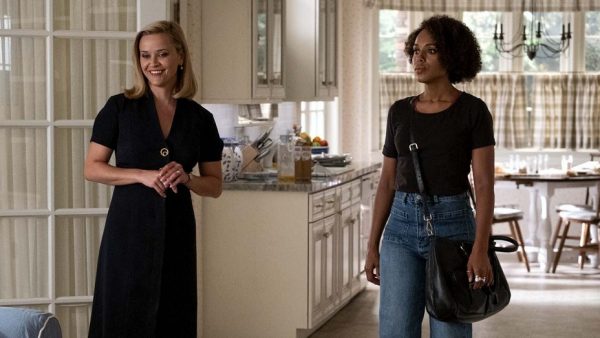Television Review: “Little Fires Everywhere” — Suburbia Ablaze
By Sarah Osman
Little Fires Everywhere borders on being binge-worthy; it’s a shame Hulu didn’t release all the episodes of the series at once.

Kerry Washington and Reese Witherspoon in Little Fires Everywhere. Photo: Hulu.
Little Fires Everywhere, Hulu’s eight-part adaptation of Celeste Ng’s novel of the same name, begins with a conflagration: a suburban mother watches in disbelief as her ideal home goes up in flames. It is tempting to see this as a metaphor for life during COVID-19; our normal existence feels as if it is going up in flames. But Little Fires Everywhere was written and created before the virus hit the world. The story line is much more conventional — it is about upper-middle-class women attempting to keep up appearances in the face of the impossible.
Starring and produced by Kerry Washington and Reese Witherspoon, Little Fires Everywhere makes a few key detours from the book, and the changes really pay off. Set in the ’90s, the series starts Witherspoon as Elena, a “perfect” suburban mother of four. The character seems to be Tracey Flick from Election (one of Witherspoon’s most iconic roles), now grown up and a winner: she has achieved everything she ever dreamed of. The woman has three perfect children and a great husband. The catch: one child, Izzy (Megan Stott), is bullied by her classmates and rebels against her mother’s wishes (she even goes so far as to scribble “Not Your Puppet” across her forehead).
In direct contrast to Elena is Mia (Kerry Washington), a down-on-her-luck photographer who floats from town to town with her teenage daughter. When she arrives in the seemingly utopian Shaker Heights, Ohio, home to Elena and her family, she senses the location might make for a good photography project and decides to stay. She ends up renting a home from Elena, and later goes on to work as the couple’s “house manager.” Mia’s race is not mentioned in the novel; here she is black. This crucial decision gives the series the opportunity to serve up commentary (sometimes blatant) on race; Mia is followed by a neighborhood watchman, and she sternly warns her daughter that she will not be treated in the same way as Elena’s children. Mia’s daughter, Pearl, faces prejudice when her high school counselor refuses to transfer her to Algebra II, despite the fact that she has already taken Geometry. The point is clear: when it comes to race, suburban America is not as “woke” as it thinks it is.
Motherhood is another major theme in Little Fires Everywhere. Both moms attempt (but fail) to do what’s best for their children. Elena doesn’t get beyond the protective: by giving her children everything they could ever want she has not prepared them for reality’s inevitable disappointments. Mia is oblivious to Pearl’s need to have a normal childhood. It is hard not to be sympathetic to the women — they are doing their best given their circumstances and they both clearly love their children.
Nods to the ’90s prevail throughout the series, which serves up plenty of nostalgic fun. During a high school dance Chumbawamba’s “Tubthumping” is played. One student declares that he will leave if a Sugar Ray song is played. Elena’s book club becomes squeamish when they pick The Vagina Monologues, lamenting that they should have selected Memoirs of a Geisha instead (ironically ignoring the charges of racial insensitivity leveled at the novel).
Not all is successful: the dialoguec an be clunky (it tries too hard to make its didactic points) and parts of the plot don’t rise above soap opera. Still, Little Fires Everywhere provides high-caliber entertainment. In many ways the show is reminiscent of another Witherspoon vehicle, Big Little Lies, which was also based on a best-selling novel and centers on a mystery. Both series poke at the ugly cracks in the polished surfaces in suburbia, but Little Fires Everywhere goes further because it comments on issues of race and class. (There is only one character of color in Big Little Lies, and her race is not treated as a problem). Another important improvement is that the children are tucked away in an elementary school in Big Little Lies. They serve as no more than a means to bring in the adult stories. In Little Fires Everywhere the teens receive much more attention, and their up-to-date struggles include dealing with pressures to fit in, bullying, and how to rebel.
Little Fires Everywhere borders on being binge-worthy; it’s a shame Hulu didn’t release all the episodes of the series at once. Given our current communal meltdown, the series reminds us that all we seem to be losing wasn’t all that perfect to begin with.
Sarah Mina Osman is a writer living in Los Angeles. She has written for Young Hollywood and High Voltage Magazine. She will be featured in the upcoming anthology, Fury: Women’s Lived Experiences Under the Trump Era
Tagged: Kerry Washington, Little Fires Everywhere, Reese Witherspoon
